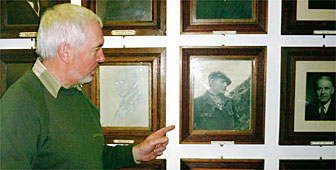Alpine legends and tall tales

On a quest to rediscover the early days of mountain exploration, Dale Bechtel followed a trail to London - home to the legendary Alpine Club. He found that its current members have kept alive the club's reputation for adventure.
I’m disappointed to find that the building housing the Alpine Club is tucked away on a litter-strewn side street on the edge of the area known as “The City”. A small unassuming plaque on the outside door is all that gives it away.
In keeping with the dishevelled appearance of the street, the rooms inside are equally untidy. Boxes clutter the floors and uneven stacks of books balance precariously on window sills.
But appearances, in this case, are deceiving. The Alpine Club headquarters is an invaluable “base camp” where members exchange information and plot their next climbs in the unexplored ranges of Tibet or Greenland, or prepare for classic ascents in the Swiss Alps.
The centrepiece of the club is the library and archives, which boast over 25,000 books, journals, expedition reports and clippings, many documenting the great risk involved in such adventures.
Librarian Margaret Ecclestone leafs through a large binder of newspaper articles from the early 20th century. “Of course the news items are very often bad news. Somebody’s fallen off, somebody’s had an accident. There’s a tragedy of some kind. That’s just the nature of newspapers really,” she says in a matter of fact tone.
But it’s also the nature of the club members not to forget the risks involved. One of them, Alan Lyall, recently completed a book on the first ascent of the Matterhorn in 1865 by early member, Edward Whymper, which was marred by the deaths during the descent of four of the seven party members.
Called “The First Descent of the Matterhorn”, Lyall’s re-telling of the climb is the latest addition to the section of the library devoted solely to Switzerland’s showcase mountain.
The library presented Lyall with a rich source of documentation, much written by early club members like Whymper.
Unsuspectingly, Whymper and his compatriots also left invaluable clues to the golden age of mountaineering in contributions they made to journals kept by their alpine guides. Several of these leather bound books have been donated to the London club and are kept in its archives.
Ecclestone carefully turns the fragile pages of the 19th century journal belonging to Swiss guide, Johann von Bergen, and lets me read a tribute from Englishman, W.E. Davidson:
“Johann von Bergen has this year amongst other minor expeditions ascended with me the Lauterbrunnen Breithorn and the Gspaltenhorn. The latter mountain we ascended in less than three hours reaching the summit at 7:50 am…He preserves in the fullest degree all those remarkable powers as a guide…”
“A large proportion of the climbers who hired those guides were British,” says Alpine Club honorary secretary, Glyn Hughes.
Such was the importance of the early British climbers that Hughes was invited to St Niklaus near Zermatt earlier this year to attend the opening of a museum dedicated to the large number of early mountain guides who came from that village.
“We have a lot of archive material, particularly their ‘Führerbücher’ (guide journals) and they were researching these and we were providing copies for them to use in their museum,” Hughes tells me.
“I’m sure they would like them back,” he laughs, “but it’s sort of like the Greeks asking for the Elgin marbles. That’s a difficult one.”
Another club member, Malcolm Eldridge – a retired school teacher – tells me that it’s still possible to find many areas in the Alps unchanged from the time when von Bergen was providing his services for the likes of Whymper and Davidson.
In 1994, Eldridge set off to follow in the footsteps of legendary mountaineer, Martin Conway, who did a complete traverse of the Alps 100 years earlier. As Eldridge talks, Ecclestone shows me a precious first edition copy of Conway’s classic, “The Alps from end to end”.
“When you do a complete traverse you find an awful lot of places that have not been changed,” says Eldridge. “So I went through very few well-developed ski resorts and I was really surprised, certainly in the Italian section and certainly in lots of the Swiss sections, by how similar it must of been to what Conway experienced 100 years before.
“One of the delights for me was going to some of the hotels that he stayed in,” he continues. “And this happened quite a bit in Switzerland, where I was able to go to the hotels and say ‘look, here’s the book, this guy stayed here 100 years ago’.
“I got reactions like ‘oh, that was my grandfather that he stayed with’ and the hotels were able to pull out the 100-year-old guest books and we were able to see where Conway and his team had signed in.”
Ecclestone puts Conway’s book and the guide journals back under lock and key. It’s early evening and a group of mountaineers from Kyrgyzstan arrives to give a lecture to the club about climbing in Central Asia.
The main speaker shows a series of slides of majestic but relatively unknown Kyrgyz mountains. To my untrained eye, they bear a striking resemblance to the Alpine peaks depicted in many of the paintings hung around the room.
Well aware of the Alpine Club’s history, the speaker doesn’t forget to mention that Kyrgyzstan is considered the Switzerland of Central Asia.
by Dale Bechtel

In compliance with the JTI standards
More: SWI swissinfo.ch certified by the Journalism Trust Initiative

You can find an overview of ongoing debates with our journalists here. Please join us!
If you want to start a conversation about a topic raised in this article or want to report factual errors, email us at english@swissinfo.ch.